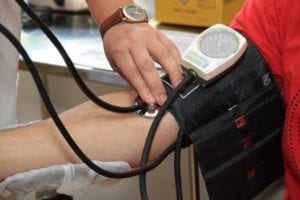Written by Taylor Woosley, Staff Writer. Consumption of 10 g of dried barberry a day resulted in improved flow mediated dilation and MCP-1, while also decreasing the circulating levels of ICAM-1 in subjects with hypertension.
 Cardiovascular diseases are major contributors to global deaths, with hypertension being a significant risk factor contributing to cardiovascular disease mortalities 1. According to the American Heart Association, about 16.5% of mortality worldwide is related to hypertension 2. Hypertension is defined as having a blood pressure equal to or greater than 140/90 mmHg 3. Chronically elevated blood pressure plays a pivotal role in heart disease, stroke, kidney disease, and dementia 4. With cardiovascular diseases on the rise worldwide, it is necessary to increase understanding of hypertension to reduce the risk of hypertension-induced heart failure.
Cardiovascular diseases are major contributors to global deaths, with hypertension being a significant risk factor contributing to cardiovascular disease mortalities 1. According to the American Heart Association, about 16.5% of mortality worldwide is related to hypertension 2. Hypertension is defined as having a blood pressure equal to or greater than 140/90 mmHg 3. Chronically elevated blood pressure plays a pivotal role in heart disease, stroke, kidney disease, and dementia 4. With cardiovascular diseases on the rise worldwide, it is necessary to increase understanding of hypertension to reduce the risk of hypertension-induced heart failure.
Barberry (Berberis vulgaris) is a shrub in the family Berberidaceae and different parts of the plant, such as the fruits, leaves, and roots, have a long history of use in traditional medicine in both the East and West 5. Phytochemical analysis of the different components of barberry shows the presence of isoquinoline alkaloids (berbamine, tetrandrine and chondocurine) which have been studied for their anti-inflammatory and immune-suppressive functions 6. Additionally, the fruits, flowers, and seeds of barberry contain high levels of phenolic compounds, including anthocyanin, pectin, and organic acids such as tannins 7. Research on the robust antioxidant and anti-inflammatory properties of barberry has proven its use as a cardioprotective herb 8.
In this 8-week, single-blinded, randomized controlled clinical trial, researchers evaluated the effects of barberry on participants with hypertension who were currently on medication. The study consisted of 84 subjects (aged 54.06 ± 10.19 years; body mass index 28.02 ± 2.18 kg/m2) who were randomly allocated to either consume 10 g/day of dried barberry or placebo. To evaluate endothelial function, changes of brachial flow-mediated dilation (FMD) and plasma macrophage/monocyte chemo-attractant protein-1 (MCP-1), vascular cellular adhesion molecule-1, and intracellular adhesion molecule-1 (ICAM-1) were measured. FMD is a commonly used non-invasive validation tool to assess endothelial function, while MCP-1 and ICAM-1 are important endothelial injury biomarkers 9. After 8 weeks of supplementation, the results were as follows:
- Flow-mediated dilation was significantly increased in the barberry group compared to placebo (B [95% CI] was 6.54% [4.39, 8.70]; p < .001).
- ICAM-1 plasma levels were significantly reduced in the barberry group compared to control (B [95% CI] was -1.61 ng/ml [-2.74, -0.48]; p = .006).
- MCP-1 was significantly lower in the barberry group compared to placebo (B [95% CI] was -37.62 pg/ml [-72.07, -3.17]; p = .033).
- FMD changes after 8 weeks of supplementation were negatively correlated with corresponding changes in ICAM-1 levels (p = .005).
- No significant correlations were observed between FMD and plasma VCAM-1 or MCP-1 (p = .94; p = .34, respectively).
The results of this study show that barberry consumption significantly improved endothelial function assessed by changes in flow-mediated dilation. Furthermore, 8-week barberry supplementation decreased plasma levels of ICAM-1 and improved MCP-1 levels compared to the control group.
Limitations of the study include the lack of measuring metabolites of phenolic compounds in subjects which could provide further insight into the role polyphenols play in hypertension. In addition, the short length of the study does not provide adequate information on the sustainability of the observed effects. Researchers suggest that future studies should be done to further evaluate the cardioprotective properties of barberry.
Source: Emamat, Hadi, Sanaz Asadian, Ali Zahedmehr, Matin Ghanavati, and Javad Nasrollahzadeh. “The effect of barberry (Berberis vulgaris) consumption on flow‐mediated dilation and inflammatory biomarkers in patients with hypertension: A randomized controlled trial.” Phytotherapy Research 35, no. 5 (2021): 2607-2615.
© 2020 John Wiley & Sons, Ltd
Click here to read the full text study.
Posted December 28, 2021.
Taylor Woosley studied biology at Purdue University before becoming a 2016 graduate of Columbia College Chicago with a major in Writing. She currently resides in Glen Ellyn, IL.
References:
- Daiber A, Steven S, Weber A, et al. Targeting vascular (endothelial) dysfunction. Br J Pharmacol. Jun 2017;174(12):1591-1619. doi:10.1111/bph.13517
- Pagidipati NJ, Gaziano TA. Estimating deaths from cardiovascular disease: a review of global methodologies of mortality measurement. Circulation. Feb 12 2013;127(6):749-56. doi:10.1161/circulationaha.112.128413
- Rodriguez-Iturbe B, Pons H, Johnson RJ. Role of the Immune System in Hypertension. Physiol Rev. Jul 1 2017;97(3):1127-1164. doi:10.1152/physrev.00031.2016
- Zhou B, Perel P, Mensah GA, Ezzati M. Global epidemiology, health burden and effective interventions for elevated blood pressure and hypertension. Nat Rev Cardiol. Nov 2021;18(11):785-802. doi:10.1038/s41569-021-00559-8
- Tabeshpour J, Imenshahidi M, Hosseinzadeh H. A review of the effects of Berberis vulgaris and its major component, berberine, in metabolic syndrome. Iran J Basic Med Sci. May 2017;20(5):557-568. doi:10.22038/ijbms.2017.8682
- Abd El-Wahab AE, Ghareeb DA, Sarhan EE, Abu-Serie MM, El Demellawy MA. In vitro biological assessment of Berberis vulgaris and its active constituent, berberine: antioxidants, anti-acetylcholinesterase, anti-diabetic and anticancer effects. BMC Complement Altern Med. Sep 5 2013;13:218. doi:10.1186/1472-6882-13-218
- Kalmarzi RN, Naleini SN, Ashtary-Larky D, et al. Anti-Inflammatory and Immunomodulatory Effects of Barberry (Berberis vulgaris) and Its Main Compounds. Oxid Med Cell Longev. 2019;2019:6183965. doi:10.1155/2019/6183965
- Abushouk AI, Salem AMA, Abdel-Daim MM. Berberis vulgaris for cardiovascular disorders: a scoping literature review. Iran J Basic Med Sci. May 2017;20(5):503-510. doi:10.22038/ijbms.2017.8674
- Kaur S, Hussain S, Kolhe K, et al. Elevated plasma ICAM1 levels predict 28-day mortality in cirrhotic patients with COVID-19 or bacterial sepsis. JHEP Rep. Aug 2021;3(4):100303. doi:10.1016/j.jhepr.2021.100303
